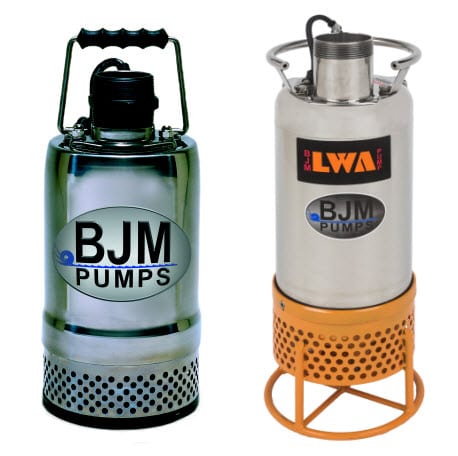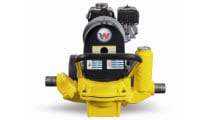If you need to lower the water table below an excavation, keep water out of foundations, pits, or tunnels, or just need to dry solid materials at your site, you’ll need a dewatering solution.
There are a lot of choices out there, from submersible dewatering pumps to towable diaphragm pumps, electric trash pumps and more.
The type you’ll need varies depending on how much liquid you need to move, and how fast, as well as factors like what the liquid is and how far you’ll need to lift it. Sludge and debris require different pumps than you’d need to move lighter materials like rainwater and wood debris.
So, how do you know you’re choosing the right one for your job?
Here are five things you need to consider when choosing a dewatering pump:
1. What’s in the Water You Need to Move?
Water almost never comes alone – almost always, your dewatering system will also need to move gravel, sand, mud, or even trash. The amount of sediment and other debris in the water you need to move determines the kind of pump you’ll need.
If you need to move heavy materials like gravel and mud…
You’ll need a pump that can handle solids. Trash pumps are usually centrifugal pumps that have a large discharge opening to avoid clogs. Heavier solids may require a shredder.
Diaphragm trash pumps like the Wacker Neuson Diaphragm Trash Pump PDT2 come in gas and diesel-powered models and are often ideal for these situations.
If your site only has light materials like sand, rainwater, and wood…
A simpler electric dewatering pump can do the job of moving clear water and water with light sediment and natural debris. For example, BJM R Series submersible dewatering pumps work well to lift light debris.
2. How Much Water Do You Need to Move, and How Fast?
The size of your pump is also an important consideration for keeping your site and workers safe.
Undersized pumps run the risk of flooding your job site when they can’t keep up with demands.
As a general rule, the bigger the piping and the larger the motor, the more water you’ll be able to move, and the faster it will work, but more isn’t always better – if you oversize your pump, you can pump the site dry and burn out the motor.
Pumps running significantly outside their ideal flow levels also can cavitate, which wears seals and bearings.
Calculating the ideal flow rate, in gallons per minute, will help you find the right pump – for help with this, contact our expert technicians.
How far does the water need to go?
You’ll also need to keep in mind where the water is going. The vertical distance you have to move liquid affects which type of hosing or piping you’ll need.
If you’re pumping into a tank or up high, you’ll need to consider friction loss, which reduces the effectiveness of a pump. As the static head (or distance you need to lift liquid upwards) increases, so does the amount of pressure that you’ll need to keep up with the inflow.
3. Choose the Right Type of Pump: Centrifugal vs. Displacement Pumps
Most dewatering pumps use centrifugal force or displacement to move water.
Centrifugal Pumps
Centrifugal water pumps use rotation to move water into the pump and pressurize the discharge flow. On most construction sites, centrifugal water pumps are a tool of choice.
Standard, trash, and submersible models are all typically centrifugal pumps.
These pumps are highly versatile and work well to move all thin liquids quickly. They also need to be filled with the liquid before use to work well. Low flow can damage the impeller, as can solids.
Positive Displacement/Rotary Pumps
Positive displacement water pumps typically use a diaphragm which contracts to pull liquids into the pump. They typically are used for very dense, viscous liquids with a lot of solids.
Though they can produce high pressure and aren’t as vulnerable to low flow, they tend to be more expensive and slower than centrifugal pumps.
4. Gas vs. Electric Pumps
Dewatering typically occurs early on during a project; there likely won’t be a built-in power supply on site.
Dewatering pumps come in both gas/diesel fuel powered and electric options.
If you’ll need to dewater your site for an extended period of time, an electric pump you can hook up to a permanent power source is probably your best bet. Electric engines also need less maintenance and can be less expensive to run depending on current fuel prices.
If the power source will be temporary, a diesel-driven pump is probably a better choice.
5. Submersible vs. Self-Priming Pumps
The best pump choice for construction is usually a submersible pump. Submersible “incapsulated” pumps can be completely submerged in liquid and work to effectively remove both liquids and solids suspended in the liquid from your site.
“Self-priming” pumps are smaller and can be more portable and easier to use, but they also tend to leave dewatered solids in the pit and stall frequently. Especially as the distance, your suction hose has to travel increases, self-priming pumps quickly become more expensive and time-consuming than they’re worth.
How to Find the Right Submersible Water Pump
There are several important factors to consider when choosing a water pump:
- Type of liquid and how fast you need to move it
- Your power source – gas or diesel? How big is your generator?
- How far your liquid needs to be moved
- What type of pump will best suit your site’s needs
A dewatering expert can be helpful in assessing the proper approach to match job site conditions. Pro Tool & Supply has all these dewatering situations covered – we carry a variety of pumps and accessories from top brands like BJM, Tsurumi, and Wacker Neuson.
Want more information, or need help figuring out which dewatering tool is best for you? Our team is happy to walk you through the selection process. Contact our expert technicians for product information or request a quote here.




